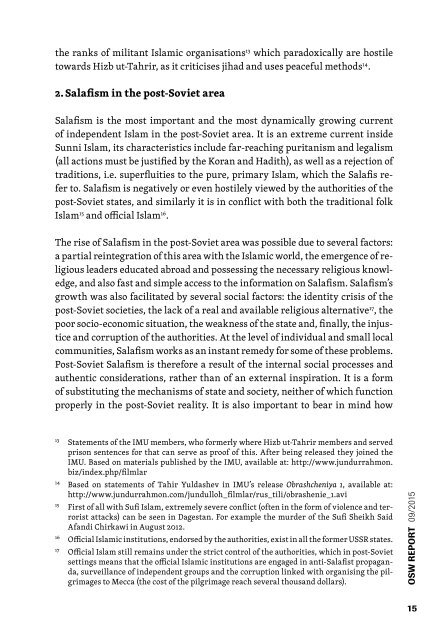HOMO JIHADICUS
homojihadicus
homojihadicus
Create successful ePaper yourself
Turn your PDF publications into a flip-book with our unique Google optimized e-Paper software.
the ranks of militant Islamic organisations 13 which paradoxically are hostile<br />
towards Hizb ut-Tahrir, as it criticises jihad and uses peaceful methods 14 .<br />
2. Salafism in the post-Soviet area<br />
Salafism is the most important and the most dynamically growing current<br />
of independent Islam in the post-Soviet area. It is an extreme current inside<br />
Sunni Islam, its characteristics include far-reaching puritanism and legalism<br />
(all actions must be justified by the Koran and Hadith), as well as a rejection of<br />
traditions, i.e. superfluities to the pure, primary Islam, which the Salafis refer<br />
to. Salafism is negatively or even hostilely viewed by the authorities of the<br />
post-Soviet states, and similarly it is in conflict with both the traditional folk<br />
Islam 15 and official Islam 16 .<br />
The rise of Salafism in the post-Soviet area was possible due to several factors:<br />
a partial reintegration of this area with the Islamic world, the emergence of religious<br />
leaders educated abroad and possessing the necessary religious knowledge,<br />
and also fast and simple access to the information on Salafism. Salafism’s<br />
growth was also facilitated by several social factors: the identity crisis of the<br />
post-Soviet societies, the lack of a real and available religious alternative 17 , the<br />
poor socio-economic situation, the weakness of the state and, finally, the injustice<br />
and corruption of the authorities. At the level of individual and small local<br />
communities, Salafism works as an instant remedy for some of these problems.<br />
Post-Soviet Salafism is therefore a result of the internal social processes and<br />
authentic considerations, rather than of an external inspiration. It is a form<br />
of substituting the mechanisms of state and society, neither of which function<br />
properly in the post-Soviet reality. It is also important to bear in mind how<br />
13<br />
Statements of the IMU members, who formerly where Hizb ut-Tahrir members and served<br />
prison sentences for that can serve as proof of this. After being released they joined the<br />
IMU. Based on materials published by the IMU, available at: http://www.jundurrahmon.<br />
biz/index.php/filmlar<br />
14<br />
Based on statements of Tahir Yuldashev in IMU’s release Obrashcheniya 1, available at:<br />
http://www.jundurrahmon.com/jundulloh_filmlar/rus_tili/obrashenie_1.avi<br />
15<br />
First of all with Sufi Islam, extremely severe conflict (often in the form of violence and terrorist<br />
attacks) can be seen in Dagestan. For example the murder of the Sufi Sheikh Said<br />
Afandi Chirkawi in August 2012.<br />
16<br />
Official Islamic institutions, endorsed by the authorities, exist in all the former USSR states.<br />
17<br />
Official Islam still remains under the strict control of the authorities, which in post-Soviet<br />
settings means that the official Islamic institutions are engaged in anti-Salafist propaganda,<br />
surveillance of independent groups and the corruption linked with organising the pilgrimages<br />
to Mecca (the cost of the pilgrimage reach several thousand dollars).<br />
PRACE OSW REPORT OSW 09/2012 09/2015<br />
15


